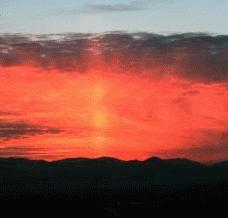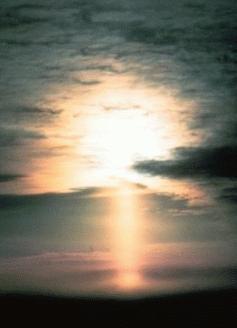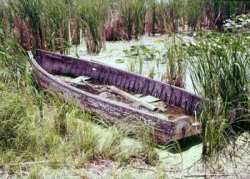Weather Almanac for February 1999
OF SUN PILLARS
AND DIAMOND DUST

In the most of the Canadian interior, February signifies that the corner has been turned on winter's extreme cold. Still, large arctic air masses can and do slip out of the far north bringing days of extreme cold to southerly regions of the country and into the United States.
I recall one such February arctic outbreak many years ago. The temperature for the day had barely exceeded minus 18° C (0° F) in the Guelph, Ontario region as it lay centered under a large arctic air mass. As I walked from the bus in the late afternoon, the soon-to-be-setting sun illuminated the horizon in brilliant light. Looking beyond my parka hood, I noticed that, although the sky was clear above me and the winds blew gently, a soft fall of snow encircled me. The snow, so fine that I could see individual crystals alight on my dark sleeve, floated around me, fluttering ever so slowly downward. In the brilliant low sunlight, the snow crystals glittered like diamond against the darkening eastern sky. The brilliance of the small illuminated crystals gives such snowfall its name: diamond dust.
At low temperatures (-18° C / 0° F) such as I was experiencing, ice crystals form hexagonal plates and/or columns. The latter resemble stubby pencils rather than the delicate branched snowflake shape our mind conjures up at the first mention of snow. When their size is less than 15-20 micrometres across, crystal plates tumble randomly through the air as they fall. But when the plates are larger, they fall so that their long dimension parallels the ground, floating downward like descending flying saucers. Columns too fall with their long axis paralleling the ground. At times, the columns rotate while falling like slow, miniature helicopter blades.
 |
|
| Sun Pillar: Photo Courtesy of NOAA/US Dept of Commerce | |
As I continued my walk homeward, the sun sank lower in the sky and was only minutes away from setting. Looking westward toward the solar orb, I saw a crimson pillar of light rising from the top of the solar disk. This was a sun pillar, a feather of light that extends vertically above and/or below the sun. Sun pillars are the most commonly seen form of pillar, but they can form in moonlight and strong artificial light as well. Most sun and moon pillars are seen when the sun/moon is low on the horizon (about 1 to 2 degrees above) and generally extend only 5 to 10 degrees directly above it.
 |
|
| Sun Pillar: Photo Courtesy of NOAA/US Dept of Commerce |
Pillars appear in the sky when snow or ice crystals reflect light forward from a strong source such as the sun. Snow crystals with plate or column shapes provide an excellent surface from which the light may reflect toward the viewer's eyes. And because the light rays are reflected, they show the colour of the incident light. For example, when the sun is higher in the sky, pillars are white in colour. But when it is near the horizon and its light colour dominantly yellow, orange, gold or red, so is the resulting pillar.
On this occasion, the sun pillar I saw formed when the solar light passed through an atmosphere filled with diamond dust. However, crystal plates and columns may also be found in ice clouds such as cirrus or alto clouds, in ice fogs, in snow falling from clouds, or in snow blowing off the surface. In fact, some of the most striking examples of pillars are found under clear, cold conditions when moderate to strong winds blow snow crystals off the ground and through the air.
The most brilliant example of pillars I ever witnessed occurred one evening when I was cross-country skiing in the moonlight. A blustery wind lofted sheets of snow off a small moraine and across the open field in front of me. Opposite from the trail I was skiing, mercury vapour street lights lined the boulevard. One this magical evening, each of those lamps wore a pillar above and below its bulb, a queue of vertical dirty-yellow feathers evenly spaced along the boulevard.
Had I been further out in the country, some distance from those city lights, I might have seen a dazzling display of pillars against the jet black sky. Robert Greenler, in his book Rainbows, Halos, and Glories, describes one such display he viewed over a small city, where the townsfolk had reported an unusual auroral display one night. Greenler believes, however, what they "really saw was a forest of high vertical light pillars, each originating from a city light; the apparent convergence to the zenith was the perspective effect of parallel lines." Such pillars can vanish and reform with amazing quickness when gusty winds rearrange the crystal alignments, giving the further impression of a shimmering aurora.
Pillars can be seen in other seasons as well as in winter when sun or moonlight penetrates a thin cirrostratus or cirrocumulus cloud deck near the horizon. But to me, pillars formed in this way are not as magical as those forming in winter when diamond dust dances in the low sky.
For more information on Light Pillars, see Weather Elements section.
Learn More From These Relevant Books
Chosen by The Weather Doctor
- Lynch, David K. and Livingston, William: Color and Light in Nature, 2nd edition, 2001, Cambridge University Press; ISBN: 0521775043 (PB).
- Dunlop, Storm: The Weather Identification Handbook: The Ultimate Guide for Weather Watchers,, 2003, The Lyons Press, ISBN 1585748579. (pb).
Written by
Keith C. Heidorn, PhD, THE WEATHER DOCTOR,
February 1, 1999
The Weather Doctor's Weather Almanac Of Sun Pillars and Diamond Dust
©1999, Keith C. Heidorn, PhD. All Rights Reserved.
Correspondence may be sent via email to: see@islandnet.com.
For More Weather Doctor articles, go to our Site Map.

I have recently added many of my lifetime collection of photographs and art works to an on-line shop where you can purchase notecards, posters, and greeting cards, etc. of my best images.

Home |
Welcome |
What's New |
Site Map |
Glossary |
Weather Doctor Amazon Store |
Book Store |
Accolades |
Email Us
|



|










